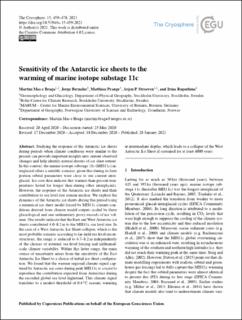| dc.contributor.author | Mas e Braga, Martim | |
| dc.contributor.author | Bernales, Jorge | |
| dc.contributor.author | Prange, Matthias | |
| dc.contributor.author | Stroeven, Arjen P | |
| dc.contributor.author | Rogozhina, Irina | |
| dc.date.accessioned | 2022-10-24T12:02:49Z | |
| dc.date.available | 2022-10-24T12:02:49Z | |
| dc.date.created | 2021-07-04T20:09:17Z | |
| dc.date.issued | 2021 | |
| dc.identifier.citation | The Cryosphere. 2021, 15 (1), 459-478. | en_US |
| dc.identifier.issn | 1994-0416 | |
| dc.identifier.uri | https://hdl.handle.net/11250/3027936 | |
| dc.description.abstract | Studying the response of the Antarctic ice sheets during periods when climate conditions were similar to the present can provide important insights into current observed changes and help identify natural drivers of ice sheet retreat. In this context, the marine isotope substage 11c (MIS11c) interglacial offers a suitable scenario, given that during its later portion orbital parameters were close to our current interglacial. Ice core data indicate that warmer-than-present temperatures lasted for longer than during other interglacials. However, the response of the Antarctic ice sheets and their contribution to sea level rise remain unclear. We explore the dynamics of the Antarctic ice sheets during this period using a numerical ice sheet model forced by MIS11c climate conditions derived from climate model outputs scaled by three glaciological and one sedimentary proxy records of ice volume. Our results indicate that the East and West Antarctic ice sheets contributed 4.0–8.2 m to the MIS11c sea level rise. In the case of a West Antarctic Ice Sheet collapse, which is the most probable scenario according to far-field sea level reconstructions, the range is reduced to 6.7–8.2 m independently of the choices of external sea level forcing and millennial-scale climate variability. Within this latter range, the main source of uncertainty arises from the sensitivity of the East Antarctic Ice Sheet to a choice of initial ice sheet configuration. We found that the warmer regional climate signal captured by Antarctic ice cores during peak MIS11c is crucial to reproduce the contribution expected from Antarctica during the recorded global sea level highstand. This climate signal translates to a modest threshold of 0.4 ∘C oceanic warming at intermediate depths, which leads to a collapse of the West Antarctic Ice Sheet if sustained for at least 4000 years. | en_US |
| dc.language.iso | eng | en_US |
| dc.publisher | European Geosciences Union | en_US |
| dc.rights | Navngivelse 4.0 Internasjonal | * |
| dc.rights.uri | http://creativecommons.org/licenses/by/4.0/deed.no | * |
| dc.title | Sensitivity of the Antarctic ice sheets to the warming of marine isotope substage 11c | en_US |
| dc.title.alternative | Sensitivity of the Antarctic ice sheets to the warming of marine isotope substage 11c | en_US |
| dc.type | Peer reviewed | en_US |
| dc.type | Journal article | en_US |
| dc.description.version | publishedVersion | en_US |
| dc.source.pagenumber | 459-478 | en_US |
| dc.source.volume | 15 | en_US |
| dc.source.journal | The Cryosphere | en_US |
| dc.source.issue | 1 | en_US |
| dc.identifier.doi | 10.5194/tc-15-459-2021 | |
| dc.identifier.cristin | 1920209 | |
| cristin.ispublished | true | |
| cristin.fulltext | original | |
| cristin.qualitycode | 2 | |

